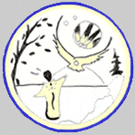![]()
Social Studies/Native Studies (SS/NS) Department
|
Frontier School Division Social Studies/Native Studies (SS/NS) Department |
 |
||||
 |
 |
 |
 |
|
 |
 |
 |
 |
|
| Return to Homepage | ||||
Kennewick Man and Control of the Past
In July 1996, a human skeleton were discovered in the Columbia River near Kennewick, Washington. Subsequent scientific analysis of “Kennewick Man,” as the bones came to be known, established that the skeleton was about 9,200 years old. Almost immediately, the war was on. Since the discovery had been made on federal land controlled by the U.S. Army Corps of Engineers, it decided in September 1996 that the great age of the skeleton meant that it belonged to one of the local aboriginal communities. Therefore, it decided to give the bones to a group of five Native American tribes that wished to rebury them. “Not so quick!” protested the scientists, “We want to study those bones!” In October 1996 the matter went to court. Eight years later, in 2004, the scientists won the right to examine the bones. In 2005, they began their study, but that’s not the end of the story. To keep abreast of the latest news, see kennewick-man.com.
Why “Kennewick Man” became a Hot Topic Kennewick Man aroused deep emotions across North America. In the past, ethnologists, anthropologists, and archaeologists had often descended on aboriginal communities and walked off with sacred articles and cultural artefacts with little or no sensitivity to local feelings. Worse still, they had dug up graves and carted away bones of known ancestors, much to the horror of living descendants. The prestigious Smithsonian Institute in Washington, for instance, is full of the bones of aboriginal Americans from every part of North America. For a long time, aboriginal Americans felt powerless to do anything about the problem, but eventually their protests led to The Native American Graves Protection and Repatriation Act (NAGPRA), which was enacted to protect the remains of aboriginal peoples and their cultures found on federal lands. It made provision for the return or repatriation of bones and other cultural artefacts, and it was on this basis that the tribes attempted to obtain Kennewick Man for reburial. Kennewick Man had been found on an eroded bank of the Columbia River on Army Corps of Engineers property leased as a county park. On public lands, repatriation priority is given to the tribe having a valid land claim to the area, if cultural affiliation of the remains with another tribe is unclear. Three Native American tribes claimed the skeleton under the terms of NAGPRA, and while one indicated a willingness to have further studies done, the other two wanted it reburied immediately. Scientists objected because they have few bones to study for insights concerning the ancient inhabitants of North America and their cultures. They saw Kennewick Man as a once-in-a-lifetime opportunity to learn more about North America’s past. When it appeared that the skeleton was in danger of being lost to any future study, several scientists filed a lawsuit to seek authority to examine the skeleton and to block implementation of NAGPRA pending a complete review of all relative evidence. Robson Bonnichsen, director of the Center for the Study of the First Americans, was one of the plaintiffs and the suit was successful. Plans for reburial were put on hold indefinitely, until the requisite scientific study had been done. This controversy raised a number of serious questions that teachers[1] and students[2] may consider. For instance,
Additional Sources of Information:
Click on the footnote number to return to the text: [1] This controversy offers teachers a wonderful avenue for stimulating student thinking. See EdSitement for lesson plans and background information. Also, for student resources on the dating of Kennewick Man, see “The Dating Game (Hot Science)” at Nova. Archaeological research has often been of great benefit to society. For instance, research into the glyphs of Central America has established that the ancients could write. Through careful research, we can now read portions of their history and learn how their societies operated and why they may have disappeared. Obviously, as we increase our understanding of the past, it can help us to explain the present and plan for the future. Current historical research, for instance, is revealing how and why Aboriginal people became marginalized in North America and elsewhere. It can also give aboriginal leaders the knowledge they need to turn things around. Of course, this whole process raises the issue of who does research and for what purpose. Often, cultural biases skew the research in certain directions, sometimes for political purposes. We need to train our students to be on the lookout for this problem. We also need to realize that all groups are prone to it. Kennewick Man offers students a chance to explore the issues connected with finds of this nature. How does one protect the interests of minority groups, while advancing human knowledge? It is a difficult question, and if you students even gain an inkling of its complexity, you will have done your job. [2] Why might a student be interested in a fight over old bones? Simply because a controversial issue like that of Kennewick Man illustrates that life isn’t all black and white; there are different points of views, and lots of greys. It gives students a chance to analyse argument for logic, bias, and the like, to take sides and present an argument, to surf the Internet for additional information. These are all important skills for students to acquire as they approach adulthood.
Last updated:
November 23, 2009
| |
 |